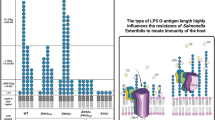Abstract
The Cry48Aa/Cry49Aa binary toxin from Lysinibacillus sphaericus is composed of a three-domain Cry-like toxin (Cry48Aa) and a binary-like protein (Cry49Aa) that work together to kill Culex quinquefasciatus mosquito larvae through a novel interaction between its two components. The aim of this study was to identify the functional regions of Cry48Aa that were involved in the interaction with Cry49Aa. Eight Cry48Aa truncated fragments were constructed from both N- and C-termini and expressed in Escherichia coli. Only the individual or combined N69K truncated fragment, a Cry48Aa N-terminal derivative consisting of three domains, showed larvicidal activity against C. quinquefasciatus larvae, while the other fragments exhibited significant loss of biological activity. Far-Western dot blot analysis showed that Cry48Aa N-terminal regions had the ability to bind to Cry49Aa protein. These results demonstrate that the N-terminal domain of Cry48Aa plays a crucial role in responsible for the full virulence to mosquito larvae and the interaction with Cry49Aa as a binary toxin.



Similar content being viewed by others
References
Park HW, Bideshi DK, Federici BA (2010) Properties and applied use of the mosquitocidal bacterium, Bacillus sphaericus. J Asia Pac Entomol 13:159–168
El-Bendary M, Priest FG, Charles JF et al (2005) Crystal protein synthesis is dependent on early sporulation gene expression in Bacillus sphaericus. FEMS Microbiol Lett 252:51–56
Jones GW, Nielsen-Leroux C, Yang Y et al (2007) A new Cry toxin with a unique two-component dependency from Bacillus sphaericus. FASEB J 21:4112–4120
Labib IM, Dawoud HA (2003) Cytopathological action in mosquito larvae fed with Bacillus sphaericus (strain faiyoum) spore/crystal complex. J Egypt Soc Parasitol 33:517–530
Charles JF, Nielson-LeRoux C, Delecluse A (1996) Bacillus sphaericus toxins: molecular biology and mode of action. Annu Rev Entomol 41:451–472
Lacey LA (2007) Bacillus thuringiensis serovariety israelensis and Bacillus sphaericus for mosquito control. J Am Mosq Control Assoc 23:133–163
Romao TP, de-Melo-Neto OP, Silva-Filha MH (2011) The N-terminal third of the BinB subunit from the Bacillus sphaericus binary toxin is sufficient for its interaction with midgut receptors in Culex quinquefasciatus. FEMS Microbiol Lett 321:167–174
Sharma M, Gupta GD, Kumar V (2018) Receptor protein of Lysinibacillus sphaericus mosquito-larvicidal toxin displays amylomaltase activity. Insect Biochem Mol Biol 93:37–46
Singkhamanan K, Promdonkoy B, Srikhirin T et al (2013) Amino acid residues in the N-terminal region of the BinB subunit of Lysinibacillus sphaericus binary toxin play a critical role during receptor binding and membrane insertion. J Invertebr Pathol 114:65–70
Limpanawat S, Promdonkoy B, Boonserm P (2009) The C-terminal domain of BinA is responsible for Bacillus sphaericus binary toxin BinA-BinB interaction. Curr Microbiol 59:509–513
Hire RS, Sharma M, Hadapad AB et al (2014) An oligomeric complex of BinA/BinB is not formed in-situ in mosquito-larvicidal Lysinibacillus sphaericus ISPC-8. J Invertebr Pathol 122:44–47
Guo QY, Cai QX, Yan JP et al (2013) Single nucleotide deletion of cqm1 gene results in the development of resistance to Bacillus sphaericus in Culex quinquefasciatus. J Insect Physiol 59:967–973
Chalegre KD, Romao TP, Tavares DA et al (2012) Novel mutations associated with resistance to Bacillus sphaericus in a polymorphic region of the Culex quinquefasciatus cqm1 gene. Appl Environ Microbiol 78:6321–6326
Jones GW, Wirth MC, Monnerat RG et al (2008) The Cry48Aa-Cry49Aa binary toxin from Bacillus sphaericus exhibits highly restricted target specificity. Environ Microbiol 10:2418–2424
de Melo JV, Jones GW, Berry C et al (2009) Cytopathological effects of Bacillus sphaericus Cry48Aa/Cry49Aa toxin on binary toxin-susceptible and -resistant Culex quinquefasciatus larvae. Appl Environ Microbiol 75:4782–4789
Srisucharitpanit K, Yao M, Promdonkoy B et al (2014) Crystal structure of BinB: a receptor binding component of the binary toxin from Lysinibacillus sphaericus. Proteins 82:2703–2712
Kelker MS, Berry C, Evans SL et al (2014) Structural and biophysical characterization of Bacillus thuringiensis insecticidal proteins Cry34Ab1 and Cry35Ab1. PLoS ONE 9:e112555
Boonserm P, Angsuthanasombat C, Lescar J (2004) Crystallization and preliminary crystallographic study of the functional form of the Bacillus thuringiensis mosquito-larvicidal Cry4Aa mutant toxin. Acta Crystallogr D 60:1315–1318
de Maagd RA, Bravo A, Crickmore N (2001) How Bacillus thuringiensis has evolved specific toxins to colonize the insect world. Trends Genet 17:193–199
Pardo-Lopez L, Soberon M, Bravo A (2013) Bacillus thuringiensis insecticidal three-domain Cry toxins: mode of action, insect resistance and consequences for crop protection. FEMS Microbiol Rev 37:3–22
Bravo A, Gill SS, Soberon M (2007) Mode of action of Bacillus thuringiensis Cry and Cyt toxins and their potential for insect control. Toxicon 49:423–435
Rezende TMT, Romao TP, Batista M et al (2017) (2017) Identification of Cry48Aa/Cry49Aa toxin ligands in the midgut of Culex quinquefasciatus larvae. Insect Biochem Mol Biol 88:63–70
Guo QY, Hu XM, Cai QX et al (2016) Interaction of Lysinibacillus sphaericus Cry48Aa/Cry49Aa toxin with midgut brush-border membrane fractions from Culex quinquefasciatus larvae. Insect Mol Biol 25:163–170
World Health Organization (1985) Informal consultation on the development of Bacillus sphaericus as microbial larvicide. Washington Document TDR/BCV/SPHAERICUS/853
Author information
Authors and Affiliations
Corresponding author
Additional information
Publisher's Note
Springer Nature remains neutral with regard to jurisdictional claims in published maps and institutional affiliations.
Rights and permissions
About this article
Cite this article
Guo, Q., Gao, Y., Xing, C. et al. The Cry48Aa N-terminal Domain is Responsible for Cry48Aa–Cry49Aa Interaction in Lysinibacillus sphaericus Toxin. Curr Microbiol 77, 1217–1222 (2020). https://doi.org/10.1007/s00284-020-01907-6
Received:
Accepted:
Published:
Issue Date:
DOI: https://doi.org/10.1007/s00284-020-01907-6




